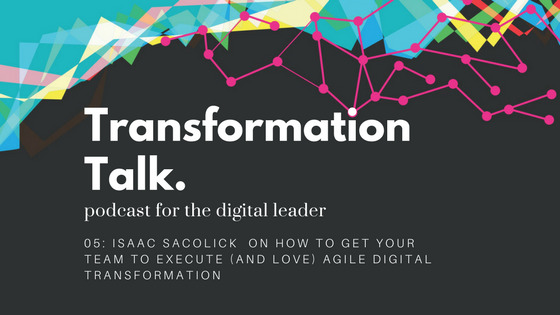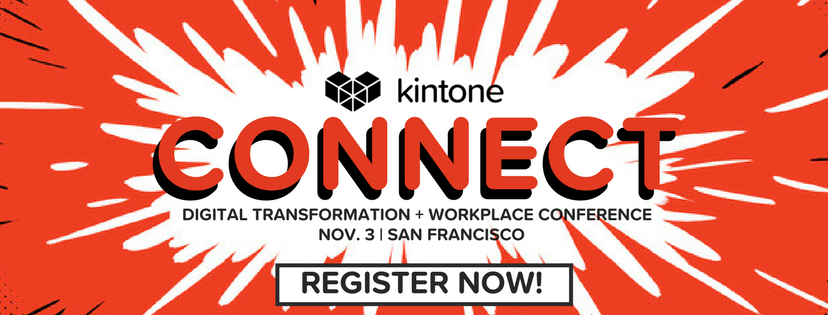This week we're speaking to Isaac Sacolick, CIO Digital Transformation consultant and writer.
 As an authority on digital transformation, Isaac has over 7,000 followers on Twitter, leading him to be named one of the Huffington Post’s Top 100 Social CIOs on Twitter in 2016. Isaac also maintains an active blog on StarCIO.com covering topics for technologists, CIOs, CMOs, and software developers.
As an authority on digital transformation, Isaac has over 7,000 followers on Twitter, leading him to be named one of the Huffington Post’s Top 100 Social CIOs on Twitter in 2016. Isaac also maintains an active blog on StarCIO.com covering topics for technologists, CIOs, CMOs, and software developers.
He specializes in consulting services covering digital strategy, product development, and agile transformation among others, and he's currently an advisory board member for Stafford & Associates. Isaac's upcoming book, Driving Digital: The Leader's Guide to Business Transformation Through Technology was released August 24th.
Isaac will be leading a workshop on "Driving Digital and Speaking on Citizen Development" at the Kintone Connect Digital Business + Workplace Collaboration Conference in San Francisco November 3.
What does “Digital Transformation” mean to you?
Businesses have always had to look at trends and readjust their business models, and this generation's no different. In digital transformation, businesses look at their strategies through the lens of new technology.
Number one, it starts with customer experiences. Consumers today have lots of options and they’re more likely to drop brand loyalty quickly. Number two, there’s a whole new set of ways people pay for things, and businesses need to cultivate those experiences if they want access to those revenue streams. The emergence of subscription models is a good example. Finally, the Internet of Things is blending the digital and physical worlds. It means that every business needs some form of digital strategy to be competitive over the next three to 10 years.
What’s the first thing you try to implement with each new client you work with?
So much about digital transformation is a new form of execution. You can think through what your digital business needs over the next few years, but if you can’t execute it, you won’t get far. I focus on agile. It focuses teams on short-term execution, and gets people thinking about priorities and the minimum viable product. I always starting with agile and the ability to execute.
What does “entrepreneurial culture” mean?
If you iterate every two weeks in an agile sprint, some of the things you sign up for are things that you know, and some of them are things you don’t. That applies in technology, in marketing, in sales. That's all part of the entrepreneurial experience of experimenting.
It’s common in employees of startups and new businesses, but you also need to change the mindset of longstanding employees. Getting away from a perception of “This is how we’ve always done things” is important, as well as looking at what should be retained from the past and what should change for the future.
One challenge is the mindset that there’s no time for something new. Businesses that don’t overcome that challenge will have a hard time executing a transformation program.
What would you say to a company that’s ready for change, but whose employees are already feeling overburdened?
Always start working with people who are naturally incentivized to do something more bleeding-edge. I use agile processes to make them successful. I use the demo parts of that program to get more people interested. When you show people making an impact, the next set of people will want to contribute too.
When I was CIO at Business Week, our demos started with 10 people. After a year, we had half the editorial team coming to our demos, which had turned into staged events. But by that time, we knew how to control feedback and capture it properly, and start and end on time. We were certainly able to expand the program.
DIGITAL TRANSFORMATION CONFERENCE: Register for Kintone Connect in San Francisco Nov. 3rd with 25% off code 'TEAMHERO'
What’s your take on citizen developer platforms and the industry that’s emerging around them?
I started with citizen development platforms before they had that name, over 10 years ago. Building tools from scratch is expensive and difficult to maintain. Back then, buying enterprise tools wasn’t accessible for a small company, so we experimented with hyper web based tools with constructs of programming, but that weren’t really coding.
One of my favorite things was going to an group that was meeting quarterly to address their operations. The leader brought up a dashboard that somebody on his team created, looking at data across multiple regions, looking at trends, and looking at whether a trend was specific to a region. As a group they came to consensus over what to do differently based on the data. That was my foray into becoming a data-driven organization and getting citizen developers equipped for handling analytics.
Now, there’s just an explosion of platforms. I have yet to meet an organization that has a deep enough IT staff to transform quickly enough. That’s where the citizen developer and low-code platforms provide value.
Let’s switch gears and talk about social media. What role does social media play in fostering business culture?
I started blogging about 12 years ago. The articles were very low-level software issues, but that’s where I got started. Then it progressed from that because when I joined Business Week, we wanted people to think of us as an expansive, technically strong brand, and that’s important for a lot of businesses today. You want customers to know that you’re technically strong and one way is to be vocal about it on social media.
Where should business leaders start if they want to use social media more?
The marketing and communication departments need to hone in on select people who can be spokespeople on a collection of platforms. Then look for opportunities where they could represent the brand and make an impact. Companies need to provide a social media policy to protect themselves as well!
What topic do you find you get most engagement from?
There are really two: best practices and culture. I love it when I can think of a new process that has had success in one or two organizations, and write it up. Those are the ones that get the most traffic. And I love talking about culture and the context of process change because it’s a conduit to get there.
Oddly enough, the posts that get the most feedback are the controversial ones, like “Please Stop Creating Microsoft Access Databases” or “Dear Spreadsheet Jockey, Get Ready for Big Data.”
Let’s move onto your upcoming book, Driving Digital. What made you decide to make the leap from blogging into print?
I always wanted to write something bigger than an article or research paper. At a certain point, I realized I have enough material on my blog to go and do it. I’ve done 10 years of startups, so I know what it’s like to disrupt. I’ve worked in media, so I know what it’s like to be disrupted. And I’ve worked as a CIO in three industries, and I have a playbook.
So I said, "Somewhere in here there's value in what I can put into print and into digital and share my experiences with other people." I looked at it as another format and then went through the challenge of “Can I actually write it, can I actually get a publisher?” I’m very happy that the American Management Association backed the book and is publishing it. Now I'm facing the new challenge of getting people interested in it, and forming a real community around it.
Hear Isaac, and a handful of other digital transformation leaders, speak in person at Kintone Connect.
About the Author
Nicole is Director of Marketing at Kintone, with 10+ years experience in content strategy, campaign management, lead acquisition and building positive work cultures of empowered, purpose-driven team members. She spent seven years as a journalist, previously serving as a CBS San Francisco digital producer, NPR contributor, Patagon Journal deputy editor and reporter for several publications, including the Chicago Tribune. She's passionate about the tech for good space, social entrepreneurship and women leadership. On the weekends, you’ll likely find her putting her Master Gardener skills to use in at community gardens in Oakland.











